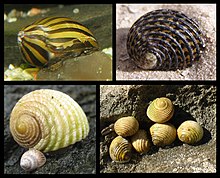| Neritimorpha Temporal range: Early Ordovician – Recent PreꞒ Ꞓ O S D C P T J K Pg N | |
|---|---|

| |
| Examples of Neritimorpha | |
| Scientific classification | |
| Domain: | Eukaryota |
| Kingdom: | Animalia |
| Phylum: | Mollusca |
| Class: | Gastropoda |
| Subclass: | Neritimorpha |
| Clades | |
|
See text | |
| Synonyms | |
|
Neritopsina Cox & Knight, 1960 | |
Neritimorpha is a clade of gastropod molluscs that contains around 2,000 extant species of sea snails, limpets, freshwater snails, land snails and slugs. This clade used to be known as the superorder Neritopsina.
Etymology
The clade’s name, Neritimorpha, is from the Ancient Greek νηρίτης (nērī́tēs 'Nerite') and μορφή (morphḗ 'form').
Description



Despite their relatively low diversity, with only around 2,000 species, neritomorphs have achieved a remarkable diversity of forms, resembling a smaller-scale version of the diversity achieved by Gastropoda as a whole. Terrestrial lifestyles have evolved at least three separate occasions in neritimorphs: the extinct Dawsonellidae and the extant Helicinidae and Hydrocenidae. Neritimorphs also include the shellless, slug-like Titiscania.
In all modern neritomorphs except neritopsids, the inner walls of the protoconch are resorbed.
Unlike most other gastropods, neritomorphs typically have calcified opercula. There is no operculum in the shellless Titiscania, and the Phenacolepadidae have a vestigial, non-calcified operculum that shows no postlarval growth.
Evolutionary history
Neritimorpha has an extremely rich geologic history, going back to early Ordovician. This clade has been considered to be a leftover of early gastropod diversification.
Neritimorpha is the sister taxon of the Apogastropoda. The clade uniting neritimorphs and apogastropods has been called either Adenogonogastropoda or Angiogastropoda.
All modern members of Neritimorpha are classified in the order Cycloneritimorpha. Neritopsoidea was the first of the four modern neritomorph superfamilies to diverge from the others.
1997 taxonomy
According to the taxonomy of the Gastropoda (Ponder & Lindberg, 1997) Neritopsina is a gastropod superorder in the subclass Orthogastropoda. The superfamily Palaeotrochoidea is contained within Neritopsina but its order placement is undetermined.
2005 taxonomy
The taxonomy of the Gastropoda by Bouchet & Rocroi, 2005 categorizes Neritimorpha as a gastropod mollusk clade. It is one of the 6 highest clades in Gastropoda. It contains the clades Cyrtoneritimorpha, Cycloneritimorpha, as well as Paleozoic Neritimorpha of uncertain position.
Clades (and uncertain position taxa) in Neritimorpha include:
- † Paleozoic Neritimorpha of uncertain position
- † clade Cyrtoneritimorpha
- clade Cycloneritimorpha
Four extant superfamilies are recognised: Helicinoidea, Hydrocenoidea, Neritoidea and Neritopsoidea.
In human society
Nerite snails are popular in the aquarium trade.
References
- Uribe, Juan E.; Colgan, Don; Castro, Lyda R.; Kano, Yasunori; Zardoya, Rafael (2016-11-01). "Phylogenetic relationships among superfamilies of Neritimorpha (Mollusca: Gastropoda)". Molecular Phylogenetics and Evolution. 104: 21–31. doi:10.1016/j.ympev.2016.07.021. hdl:10261/156227. ISSN 1055-7903. PMID 27456746.
- Bailly, Dictionnaire Grec Francais. 1935.
- ^ Uribe, Juan E.; Colgan, Don; Castro, Lyda R.; Kano, Yasunori; Zardoya, Rafael (2016-07-22). "Phylogenetic relationships among superfamilies of Neritimorpha (Mollusca: Gastropoda)". Molecular Phylogenetics and Evolution. 104: 21–31. doi:10.1016/j.ympev.2016.07.021. hdl:10261/156227. ISSN 1055-7903.
- ^ Kano, Yasunori; Chiba, Satoshi; Kase, Tomoki (2002-12-07). "Major adaptive radiation in neritopsine gastropods estimated from 28S rRNA sequences and fossil records". Proceedings of the Royal Society of London. Series B: Biological Sciences. 269 (1508): 2457–2465. doi:10.1098/rspb.2002.2178. eISSN 1471-2954. ISSN 0962-8452. PMC 1691182.
- ^ Bandel, Klaus; Frýa, Jiři (1999-09-30). "Notes on the evolution and higher classification of the subclass Neritimorpha (Gastropoda) with the description of some new taxa" (PDF). Geologica et Palaeontologica. 33: 219–235.
- Kano, Yasunori (September 2006). "Usefulness of the opercular nucleus for inferring early development in neritimorph gastropods". Journal of Morphology. 267 (9): 1120–1136. doi:10.1002/jmor.10458. eISSN 1097-4687. ISSN 0362-2525.
- ^ Cunha, Tauana Junqueira; Giribet, Gonzalo (2019-03-13). "A congruent topology for deep gastropod relationships". Proceedings of the Royal Society B: Biological Sciences. 286 (1898): 20182776. doi:10.1098/rspb.2018.2776. ISSN 0962-8452. PMC 6458328.
- Uribe, Juan E; González, Vanessa L; Irisarri, Iker; Kano, Yasunori; Herbert, David G; Strong, Ellen E; Harasewych, M G (2022-10-12). "A phylogenomic backbone for gastropod molluscs". Systematic Biology. 71 (6): 1271–1280. doi:10.1093/sysbio/syac045. eISSN 1076-836X. hdl:10261/279410. ISSN 1063-5157.
- Simone, Luiz Ricardo L. (2011). "Phylogeny of the Caenogastropoda (Mollusca), based on comparative morphology". Arquivos de Zoologia. 32 (4): 161–323. ISSN 0066-7870.
- Bouchet P. & Rocroi J.-P. (Ed.); Frýda J., Hausdorf B., Ponder W., Valdes A. & Warén A. 2005. Classification and nomenclator of gastropod families. Malacologia: International Journal of Malacology, 47(1-2). ConchBooks: Hackenheim, Germany. ISBN 3-925919-72-4. ISSN 0076-2997. 397 pp. http://www.vliz.be/Vmdcdata/imis2/ref.php?refid=78278
- "Nerite Snails: Algae Eating, Care, Lifespan, Eggs - Video". Aquarium Care Basics. Retrieved 2022-07-14.
| Taxon identifiers | |
|---|---|
| Neritimorpha | |